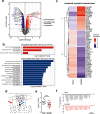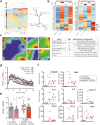Astroglial modulation of synaptic function in the non-demyelinated cerebellar cortex is dependent on MyD88 signaling in a model of toxic demyelination
- PMID: 39988657
- PMCID: PMC11849172
- DOI: 10.1186/s12974-025-03368-9
Astroglial modulation of synaptic function in the non-demyelinated cerebellar cortex is dependent on MyD88 signaling in a model of toxic demyelination
Abstract
Progressive neurological decline in multiple sclerosis is associated with axonal loss and synaptic dysfunction in the non-demyelinated normal appearing gray matter (NAGM) and prominently in the cerebellum. In contrast to early disease stages, where synaptic and neuro-axonal pathology correlates with the extent of T cell infiltration, a prominent role of the innate immune system has been proposed for progressive MS. However, the specific contribution of microglia and astrocytes to synaptic cerebellar pathology in the NAGM- independent of an adaptive T cell response - remains largely unexplored. In the present study, we quantified synaptic changes in the cerebellar NAGM distant from demyelinated lesions in a mouse model of toxic demyelination. Proteomic analysis of the cerebellar cortex revealed differential regulation of synaptic and glutamate transport proteins in the absence of evident structural synaptic pathology or local gray matter demyelination. At the functional level, synaptic changes manifested as a reduction in frequency-dependent facilitation at the parallel fiber- Purkinje cell synapse. Further, deficiency of MyD88, an adaptor protein of the innate immune response, associated with a functional recovery in facilitation, reduced changes in the differential expression of synaptic and glutamate transport proteins, and reduced transcription levels of inflammatory cytokines. Nevertheless, the characteristics of demyelinating lesions and their associated cellular response were similar to wild type animals. Our work brings forward an experimental paradigm mimicking the diffuse synaptic pathology independent of demyelination in late stage MS and highlights the complex regulation of synaptic pathology in the cerebellar NAGM. Moreover, our findings suggest a role of astrocytes, in particular Bergmann glia, as key cellular determinants of cerebellar synaptic dysfunction.
© 2025. The Author(s).
Conflict of interest statement
Declarations. Ethical approval: Not applicable. Competing interests: The authors declare no competing interests.
Figures





References
-
- Peterson JW, Bö L, Mörk S, Chang A, Trapp BD. Transected neurites, apoptotic neurons, and reduced inflammation in cortical multiple sclerosis lesions. Ann Neurol. 2001;50:389–400. - PubMed
-
- Vercellino M, Plano F, Votta B, Mutani R, Giordana MT, Cavalla P. Grey Matter Pathology in multiple sclerosis. J Neuropathology Experimental Neurol. 2005;64:1101–7. - PubMed
-
- Wegner C, Esiri M, Chance S, Palace J, Matthews P. Neocortical neuronal, synaptic, and glial loss in multiple sclerosis. Neurology. 2006;67:960–7. - PubMed
-
- Jürgens T, Jafari M, Kreutzfeldt M, Bahn E, Brück W, Kerschensteiner M, Merkler D. Reconstruction of single cortical projection neurons reveals primary spine loss in multiple sclerosis. Brain. 2016;139:39–46. - PubMed
MeSH terms
Substances
LinkOut - more resources
Full Text Sources
Molecular Biology Databases

